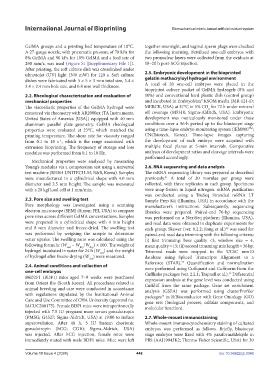Page 456 - IJB-10-4
P. 456
International Journal of Bioprinting Biomechanical mimic-based artificial oviduct system
GelMA groups and a printing bed temperature of 10°C. together overnight, and vaginal sperm plugs were checked
A 27-gauge nozzle, with pneumatic pressure of 70 kPa for the following morning. Fertilized one-cell embryos with
8% GelMA and 90 kPa for 10% GelMA and a feed rate of two pronuclear layers were collected from the oviducts at
250 mm/s, was used (Figure S1 [Supplementary File 1]). 18–20 h post-hCG injection.
After printing, the soft culture dish was crosslinked under
ultraviolet (UV) light (300 mW) for 120 s. Soft culture 2.5. Embryonic development in the bioprinted
dishes were fabricated with 5 × 5 × 3 mm total size, 3.4 × gelatin methacryloyl hydrogel environment
3.4 × 2.4 mm hole size, and 0.8 mm wall thickness. A total of 20 one-cell embryos were placed in the
bioprinted culture pocket of GelMA hydrogels (8% and
2.2. Rheological characterization and evaluation of 10%) and conventional hard plastic dish (control group)
mechanical properties and incubated in EmbryoMax® KSOM media (MR-121-D;
The viscoelastic properties of the GelMA hydrogel were MERCK, USA) at 37°C in 5% CO for 72 h under mineral
2
measured via rheometry with AR2000ex (TA Instruments, oil coverage (M5310; Sigma-Aldrich, USA). Embryonic
United States of America [USA]) equipped with 40 mm development was meticulously monitored under these
aluminum parallel plate geometry. GelMA rheological conditions over a 96-h period up to the blastocyst stage
TM
properties were evaluated at 23°C, which matched the using a time-lapse embryo monitoring system (iEM900 ;
printing temperature. The shear rate for viscosity ranged CNCbiotech, Korea). Time-lapse images capturing
from 0.1 to 10 s , which is the range associated with the development of each embryo were acquired with
−1
extrusion bioprinting. The frequency of storage and loss multiple focal planes at 5-min intervals. Comparative
modulus was performed from 0.1 to 10 Hz. analyses of development ratios and cleavage intervals were
performed accordingly.
Mechanical properties were analyzed by measuring
Young’s modulus via a compression test using a universal 2.6. RNA sequencing and data analysis
test machine (RB301 UNITECH-M; R&B, Korea). Samples The mRNA sequencing library was prepared as described
were manufactured in a cylindrical shape with 4.0 mm previously. A total of 30 morulae per group were
31
diameter and 2.5 mm height. The sample was measured collected, with three replicates in each group. Specimens
with a 20 kgf load cell at 1 mm/min. were snap-frozen in liquid nitrogen. mRNA purification
was conducted using a TruSeq Stranded mRNA LT
2.3. Pore size and swelling test Sample Prep Kit (Illumina, USA) in accordance with the
Pore morphology was investigated using a scanning manufacturer’s instructions. Subsequently, sequencing
electron microscope (SEM) (Sirion; FEI, USA) to compare libraries were prepared. Paired-end 76-bp sequencing
pore sizes across different GelMA concentrations. Samples was performed on a NextSeq platform (Illumina, USA),
were prepared in a cylindrical shape with 4 mm height and read data were obtained in duplicate experiments for
and 8 mm diameter and freeze-dried. The swelling test each group. Skewer (ver. 0.2.2; Jiang et al.) was used for
32
was performed by weighing the sample to determine paired-end read data trimming with the following criteria:
water uptake. The swelling ratio was calculated using the (i) first trimming: base quality <3, window size = 4,
following formula: (W – W /W ) × 100. The weight of mean quality = 15; (ii) second trimming: min length = 36 bp.
wet
dry
dry
hydrogel incubated in water for 24 h (W ) and the weight Trimmed reads were mapped to the UCSC mm10
wet
of hydrogel after freeze-drying (W ) were measured. database using Spliced Transcripts Alignment to a
dry
Reference (STAR). Quantification and normalization
33
2.4. Animal conditions and collection of were performed using Cuffquant and Cuffnorm from the
one-cell embryos Cufflinks packages (ver. 2.2.1; Trapnell et al.). Differential
34
B6D2F1 (BDF1) mice aged 7–9 weeks were purchased expression analysis at the gene level was conducted using
from Orient Bio (South Korea). All procedures related to Cuffdiff from the same package. Gene set enrichment
animal breeding and care were conducted in accordance analysis (GSEA) was performed using clusterProfiler
with regulations stipulated by the Institutional Animal packages in R/Bioconductor with Gene Ontology (GO)
35
Care and Use Committee of CHA University (approval no. gene sets (biological process, cellular components, and
IACUC200175). Female BDF1 mice were intraperitoneally molecular function).
injected with 7.5 IU pregnant mare serum gonadotropin
(PMSG; G4527; Sigma-Aldrich, USA) at 19:00 to induce 2.7. Whole-mount immunostaining
superovulation. After 48 h, 5 IU human chorionic Whole-mount immunocytochemistry staining of cultured
gonadotropin (hCG; CG10; Sigma-Aldrich, USA) embryos was performed as follows. Briefly, blastocyst
was injected. After hCG injection, female mice were stage embryos were fixed with 4% paraformaldehyde in
immediately mated with male BDF1 mice. Mice were left PBS (AAJ19943K2; Thermo Fisher Scientific, USA) for 30
Volume 10 Issue 4 (2024) 448 doi: 10.36922/ijb.3346

